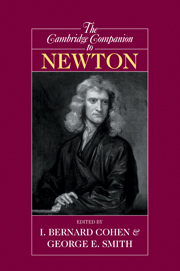Book contents
- Frontmatter
- Introduction
- 1 Newton's philosophical analysis of space and time
- 2 Newton's concepts of force and mass, with notes on the Laws of Motion
- 3 Curvature in Newton's dynamics
- 4 The methodology of the Principia
- 5 Newton's argument for universal gravitation
- 6 Newton and celestial mechanics
- 7 Newton's optics and atomism
- 8 Newton's metaphysics
- 9 Analysis and synthesis in Newton's mathematical work
- 10 Newton, active powers, and the mechanical philosophy
- 11 The background to Newton's chymistry
- 12 Newton's alchemy
- 13 Newton on prophecy and the Apocalypse
- 14 Newton and eighteenth-century Christianity
- 15 Newton versus Leibniz: from geometry to metaphysics
- 16 Newton and the Leibniz-Clarke correspondence
- Bibliography
- Index
1 - Newton's philosophical analysis of space and time
Published online by Cambridge University Press: 28 May 2006
- Frontmatter
- Introduction
- 1 Newton's philosophical analysis of space and time
- 2 Newton's concepts of force and mass, with notes on the Laws of Motion
- 3 Curvature in Newton's dynamics
- 4 The methodology of the Principia
- 5 Newton's argument for universal gravitation
- 6 Newton and celestial mechanics
- 7 Newton's optics and atomism
- 8 Newton's metaphysics
- 9 Analysis and synthesis in Newton's mathematical work
- 10 Newton, active powers, and the mechanical philosophy
- 11 The background to Newton's chymistry
- 12 Newton's alchemy
- 13 Newton on prophecy and the Apocalypse
- 14 Newton and eighteenth-century Christianity
- 15 Newton versus Leibniz: from geometry to metaphysics
- 16 Newton and the Leibniz-Clarke correspondence
- Bibliography
- Index
Summary
INTRODUCTION: PHILOSOPHICAL CONTROVERSY OVER NEWTON’S IDEAS OF SPACE, TIME, AND MOTION
Newton's concepts of “absolute space,” “absolute time,” and “absolute motion” met with serious objections from such philosophical contemporaries as Huygens, Leibniz, and Berkeley. Among philosophers of the early twentieth century, after the advent of Special and General Relativity, the objections bordered on scorn: Newton's concepts were not only lately outmoded, but they were also epistemologically inherently defective, empirically unfounded - concepts not scientific at all, but “metaphysical,” in so far as science is concerned precisely with “sensible measures” rather than obscure notions of what is “absolute.” The prevailing idea was that Einstein had established not only a new theory of space and time, but a deeper philosophical viewpoint on space and time in general. From this viewpoint, space, time, and motion are essentially relative, and to call them absolute was an elementary philosophical error. As Einstein put it, General Relativity had taken from space and time “the last remnant of physical objectivity.”
The philosophical motivation for this viewpoint seems obvious. Space cannot be observed; all that we can observe is the relative displacement of observable things. Therefore, if we observe two bodies in relative motion, to say that one of them is “really” moving, or that it is moving “relative to absolute space,” is to pass beyond the bounds of empirical science. If we wish to decide which bodies are moving, we have to construct a frame of reference – that is, we must designate some reference-points to be fixed, and compare the motions of other bodies to these.
- Type
- Chapter
- Information
- The Cambridge Companion to Newton , pp. 33 - 56Publisher: Cambridge University PressPrint publication year: 2002
- 15
- Cited by



